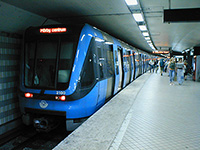Mar 9 2009
An advanced sensor technique and data processing used to monitor air conditioning inside space stations is now being used in an innovative fire protection system for Stockholm's metro system.
 Stockholm metro train. Credit: Jorges
Stockholm metro train. Credit: Jorges
This technique, called the ‘electronic nose’, was developed for ESA in the 1990s as a contribution to the Russian MIR programme to ensure constant monitoring of the air inside the MIR space station.
The system was successfully completed and operated on the 1995 and 1997 MIR missions, and proved its worth when it ‘smelled’ the very early signs of a fire arising onboard the 1997 mission.
The ‘electronic nose’ system consists of three elements:
- a sensor that acts in the same way as the neurons inside a human nose as receptor of odours
- a microprocessor that characterized the odours in a way similar to the nose’s olfactory bulbs
- a software processing system that works like the human brain to interpreter the odours and to take proper action
After a series of tests covering all stages of a fire, from smouldering to an open fire, engineers of EADS RST Rostock System-Technik used the ‘electronic nose’ technology to develop an early fire recognition system for industrial applications.
Together with the Swedish company Firefly, the system was developed into an ‘electronic nose’ to detect fires in tunnels and underground train stations.
After intensive testing in the Stockholm underground, a series production of the device is now underway.
The contract with the Stockholm underground corporation, to equip its tunnels and stations with this novel detection system, will cover a total of 56 metro stations and 60 km of tunnels.
So far, the tunnels and stations of most underground infrastructures worldwide are equipped with conventional fire recognition systems that rely on smoke detectors. These are susceptible to disturbances of the rough underground environmental conditions like humidity and fine types of dust, to which the ‘electronic nose’ is much less susceptible.
"Technologies developed for use in space must not only be sophisticated and fail-proof, they must also be extremely robust to withstand the extreme conditions of the space environment and the ferocious shakes of a spacecraft launch. They must function in the vacuum of space and be able to face temperatures from sizzling hot to freezing cold. One can say that the extreme space environment is a driver for innovative solutions that can then be applied elsewhere," says Frank M. Salzgeber, head of ESA’s Technology Transfer Programme Office.
"Many of the technology developments for our space programmes have shown their worth in non-space fields by providing novel solutions to problems on Earth. The ‘electronic nose’ improving safety in the Stockholm metro system is a very good example of how spin-offs from European space technology can provide successful solutions in everyday life on Earth."